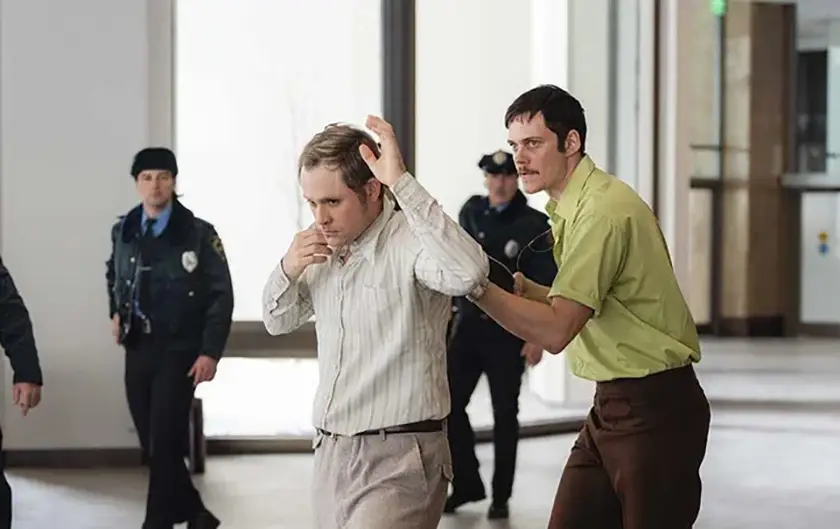Based on a real story, the 1970s-set Dead Man’s Wire is a funny and poignant reflection on today’s world.
Director: Gus Van Sant
Genre: Crime, Drama, Thriller, Biographical
Run Time: 105′
Venice World Premiere: September 2, 2025
U.S. Release Date: TBA
U.K. Release Date: TBA
“February 8, 1977.” The historical setting is one of the first things we learn about Dead Man’s Wire. That, and the fact that it is based on a real story. The film then starts with Tony Kiritsis (Bill Skarsgård, of Nosferatu), a young man with ambitious dreams of business and wealth, walking into Meridian Mortgage’s building for a meeting. But the reality is much more dangerous: Tony is there to put an elaborate plan in motion.
Thanks to an ingenious device, he threatens the life of Richard Hall (Dacre Montgomery, of Stranger Things), the manager of Meridian Mortgage, and son of the owner. Tony takes Richard hostage to obtain an apology from the company and the money he believes he is owed.
From the opening scene, Gus Van Sant’s latest movie flies by, keeping its viewers on the edge of their seat as they wait for the moment when the hostage situation will finally be resolved. Naturally, the premise of the story would make it a very tense movie, but the way it is filmed makes it even more so thanks to its tight pacing, excellent performances that make us care for all the characters involved, and quick and witty humour. In its first act, Dead Man’s Wire has a lot of information to deliver to its audience. Despite this, the film never falls into the trap of flat info-dumping, keeping its exposition to a minimum and always successfully delivering its information in conflict, making it land a lot better with the audience.
As a historical crime film, Dead Man’s Wire is a relatively heavy film given its subject matter, but this never really weighs on the audience. This is thanks to its excellent pacing and to the comedic element that seems to be so effortlessly included in the narrative of the movie. The black humour works incredibly well and contributes to making Gus Van Sant’s latest film such a memorable one.

The film is set in the 1970s and yet there are multiple elements of this story that still very much speak to today’s world. First and foremost, Dead Man’s Wire offers a poignant critique of the American dream, just like the real-life events it was inspired by. Ultimately, Tony is a man who was wronged by the system he has always believed in, finally realising that it is only the rich minority that will get richer, while the rest of the population will continue to struggle.
This discovery leaves Tony bitter and disillusioned with the capitalistic system and its representatives, namely Meridian Motors and its managerial class. While his actions in Dead Man’s Wire are not excusable, it is not so hard to see where he was coming from in a world like ours that is growing more and more aware of the blatant lie that the American dream often represents. Bill Skarsgård’s human and layered portrayal of the main character helps us see both the reasons and the madness behind such a desperate act, making the viewers equally scared of and somewhat sympathetic towards the main antagonist.
The film also focuses quite a lot on the journalism part of the story. While these scenes are significantly less strong, and partially take our attention away from the main story, they still offer a valuable insight into the real-life event Dead Man’s Wire is inspired by. The part of the story that involves the radio, and most notably a wonderful Colman Domingo as a local DJ, serves a similar purpose, but is a lot more successful and interesting to watch.
One one hand, Tony’s obsession with both the radio and tv journalism is a testament to how mass media can function as an echo chamber of his message and contribute to the hysteria that led him on this mission. On the other, the way local journalists, in particular the young reporter played by Myha’la in Dead Man’s Wire, jump at the chance to cover this event for their own professional interests or increased viewership speaks to the way journalism still works today, with a prevalent attention for likes, clickbates, and attention rather than the people who are involved in the story that is being reported.
Despite its excellent script and wonderful performances by the main cast, there are some minor elements of Dead Man’s Wire that do not necessarily work. As it goes on, the movie often includes photographs in black and white that enhance the overall context of these events as a newsworthy story in the 70s. However, the still frames easily distance the viewers from what is happening in the film and the tension that it relies so heavily on to tell its story. More often than not, the inclusion of black and white pictures would only serve as a reminder that we are in fact watching a film and, therefore, only took me out of the story rather than making it more impactful.
Overall, Dead Man’s Wire is a brilliant and surprisingly hilarious film that manages to speak to today’s struggle against a capitalist society that only wants to see a rich minority succeed. The movie is not only funny but also feels incredibly timely and urgent in its exploration of these themes that were as relevant in 1977 when the events happened as they are in 2025 when the film came out.
Dead Man’s Wire: Movie Plot & Recap
Synopsis:
Believing to have been wronged by Meridian Mortgage Company, Tony Kiritsis seeks out justice by taking Richard Hall, its president, hostage.
Pros:
- The film delivers a very tense atmosphere with tight pacing
- The clever script and excellent comedic timing by the actors bring out the humorous element of the story
Cons:
- The black and white still images are abruptly included and often interrupt the narration of the film.
Dead Man’s Wire had its World Premiere at the Venice Film Festival on September 2, 2025. The film will be screened at TIFF on September 7.

